Moderate overlap front: original test
Rating applies to 2000-06 models
Tested vehicle: 2000 Nissan Sentra GXE 4-door
The Nissan Sentra was redesigned for the 2000 model year.
| Evaluation criteria | Rating |
|---|---|
| Overall evaluation | |
| Structure and safety cage | |
| Driver injury measures | |
| Head/neck | |
| Chest | |
| Leg/foot, left | |
| Leg/foot, right | |
| Driver restraints and dummy kinematics | |
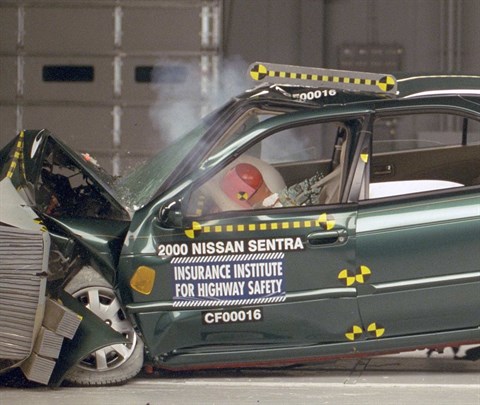
Action shot taken during the frontal offset crash test.

The dummy's position in relation to the steering wheel and instrument panel after the crash test indicates that the driver's survival space was maintained reasonably well.
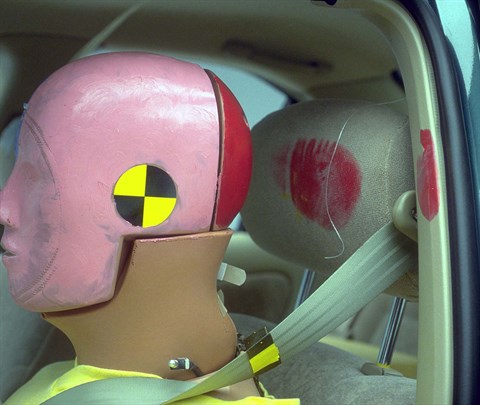
Smeared greasepaint indicates where the dummy's head hit the B-pillar during rebound, producing a high head acceleration.
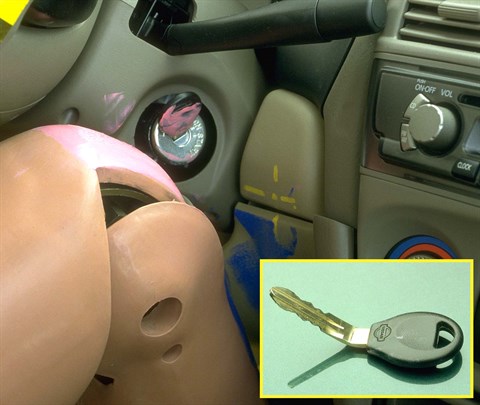
Smeared pink and blue greasepaint shows where the dummy's right knee and shin hit the ignition key and knee bolster. The key was bent during the impact (inset).
Measures of occupant compartment intrusion on driver side
| Evaluation criteria | Measurement |
|---|---|
| Test ID | CF00016 |
| Footwell intrusion | |
| Footrest (cm) | 16 |
| Left (cm) | 20 |
| Center (cm) | 18 |
| Right (cm) | 15 |
| Brake pedal (cm) | 14 |
| Instrument panel rearward movement | |
| Left (cm) | 7 |
| Right (cm) | 5 |
| Steering column movement | |
| Upward (cm) | 1 |
| Rearward (cm) | 6 |
| A-pillar rearward movement (cm) | 5 |
Driver injury measures
| Evaluation criteria | Measurement |
|---|---|
| Test ID | CF00016 |
| Head | |
| HIC-15 | 218 |
| Peak gs at hard contact | 146 |
| Neck | |
| Tension (kN) | 1.6 |
| Extension bending moment (Nm) | 39 |
| Maximum Nij | 0.34 |
| Chest maximum compression (mm) | 30 |
| Legs | |
| Femur force - left (kN) | 2.8 |
| Femur force - right (kN) | 1.4 |
| Knee displacement - left (mm) | 8 |
| Knee displacement - right (mm) | 14 |
| Maximum tibia index - left | 0.55 |
| Maximum tibia index - right | 0.51 |
| Tibia axial force - left (kN) | 1.3 |
| Tibia axial force - right (kN) | 3.3 |
| Foot acceleration (g) | |
| Left | 79 |
| Right | 85 |
Side: original test
Rating applies to 2000-06 models
Tested vehicle: 2004 Nissan Sentra 1.8 S 4-door without optional side airbags
The Nissan Sentra was redesigned for the 2000 model year.
| Evaluation criteria | Rating |
|---|---|
| Overall evaluation | |
| Structure and safety cage | |
| Driver injury measures | |
| Head/neck | |
| Torso | |
| Pelvis/leg | |
| Driver head protection The dummy's head was hit by the intruding barrier, producing high head injury measures. |
|
| Rear passenger injury measures | |
| Head/neck | |
| Torso | |
| Pelvis/leg | |
| Rear passenger head protection The dummy's head was hit by the window glass, window sill, and pillar behind the rear passenger door, producing moderately high head injury measures. |
|
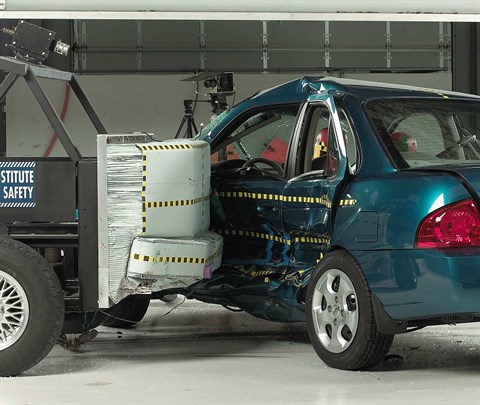
View of the vehicle and barrier just after the crash test.

View of the vehicle after the crash with doors removed, showing damage to the occupant compartment.
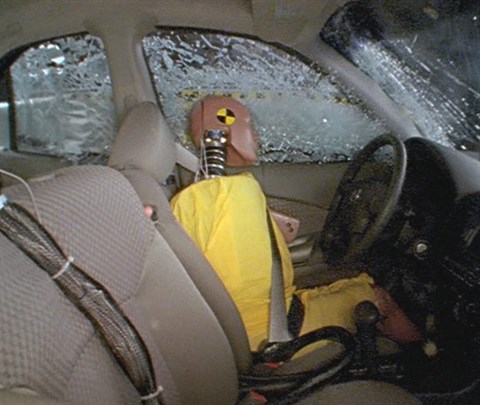
Action shot taken during the side impact crash test showing the driver dummy's head being hit by the intruding barrier.
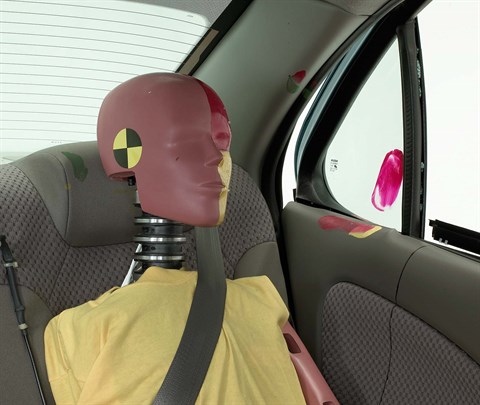
Smeared greasepaint shows where the rear passenger dummy's head was hit by the window glass and window sill of the rear passenger door and by the pillar behind the door.
Measures of occupant compartment intrusion on driver side
| Test ID | CES0419 |
|---|---|
| B-pillar to longitudinal centerline of driver's seat (cm) | -1.0 |
| Negative numbers indicate the amount by which the crush stopped short of the seat centerline. | |
Driver injury measures
| Evaluation criteria | Measurement |
|---|---|
| Test ID | CES0419 |
| Head HIC-15 | 3,200 |
| Neck | |
| Tension (kN) | 1.9 |
| Compression (kN) | 1.0 |
| Shoulder | |
| Lateral deflection (mm) | 54 |
| Lateral force (kN) | 2.0 |
| Torso | |
| Maximum deflection (mm) | 64 |
| Average deflection (mm) | 44 |
| Maximum deflection rate (m/s) | 9.65 |
| Maximum viscous criterion (m/s) | 2.53 |
| Pelvis | |
| Iliac force (kN) | 4.3 |
| Acetabulum force (kN) | 4.5 |
| Combined force (kN) | 7.7 |
| Left femur | |
| L-M force (kN) | 0.6 |
| L-M moment (Nm) | 106 |
| A-P moment (Nm) | 33 |
Passenger injury measures
| Evaluation criteria | Measurement |
|---|---|
| Test ID | CES0419 |
| Head HIC-15 | 697 |
| Neck | |
| Tension (kN) | 1.8 |
| Compression (kN) | 0.2 |
| Shoulder | |
| Lateral deflection (mm) | 43 |
| Lateral force (kN) | 1.8 |
| Torso | |
| Maximum deflection (mm) | 42 |
| Average deflection (mm) | 31 |
| Maximum deflection rate (m/s) | 3.23 |
| Maximum viscous criterion (m/s) | 0.48 |
| Pelvis | |
| Iliac force (kN) | 1.7 |
| Acetabulum force (kN) | 1.8 |
| Combined force (kN) | 2.7 |
| Left femur | |
| L-M force (kN) | 1.5 |
| L-M moment (Nm) | 188 |
| A-P moment (Nm) | -58 |
Head restraints & seats
Seat type: Base seats
| Overall evaluation | |
|---|---|
| Dynamic rating | |
| Seat/head restraint geometry |
| Seat type | Base seats |
|---|---|
| Geometry | |
| Backset (mm) | 72 |
| Distance below top of head (mm) | 95 |
| Seat design parameters | |
| Pass/fail | Fail |
| Max T1 acceleration (g) | 0.0 |
| Head contact time (ms) | |
| Force rating | 0 |
| Neck forces | |
| Max neck shear force (N) | |
| Max neck tension (N) | |
About the head restraint & seat test
Currently, IIHS tests apply only to front seats.
